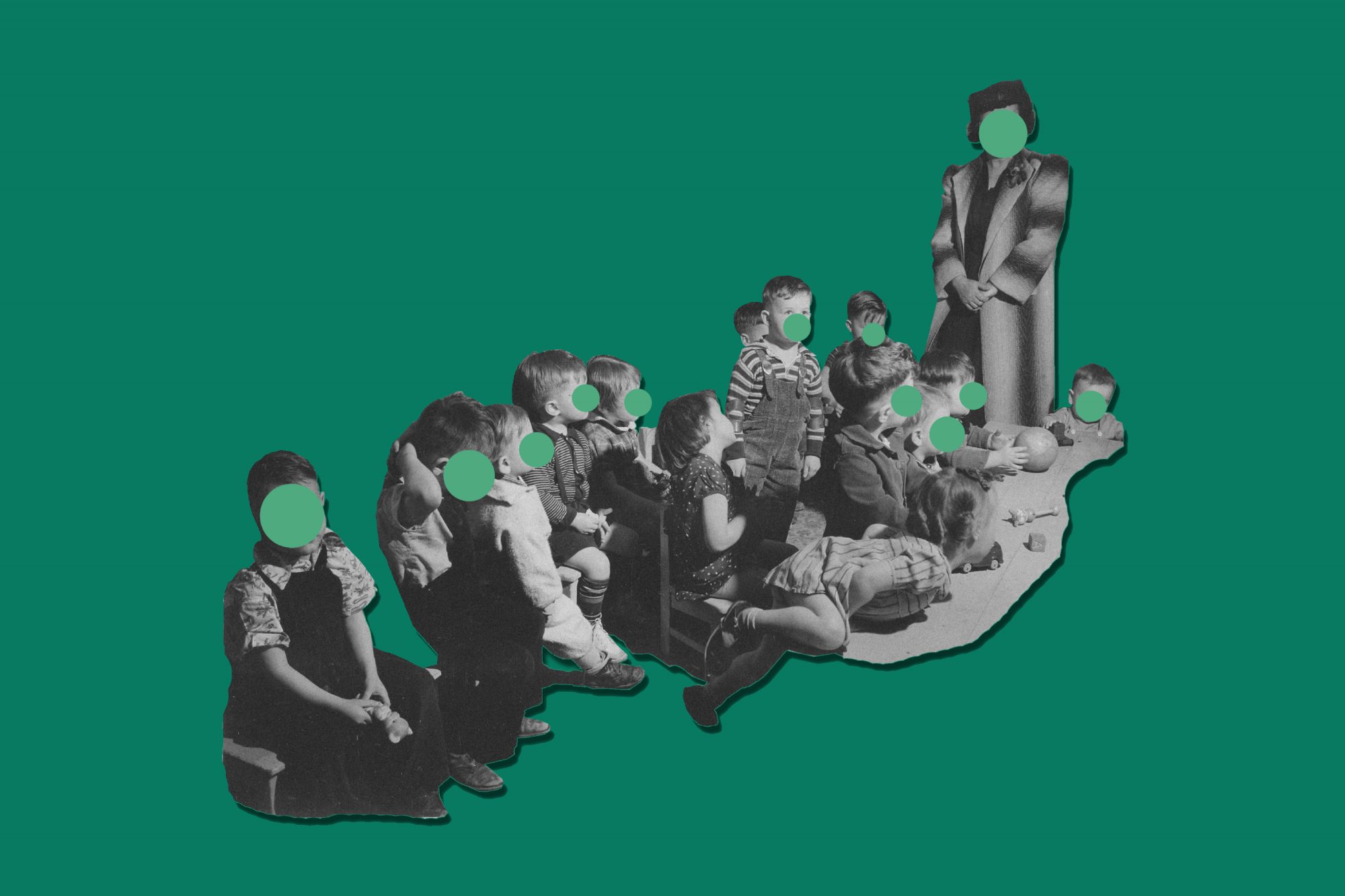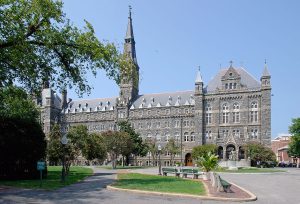As the fall semester ends and coronavirus cases soar, Georgetown University’s child care crisis persists.
Teaching in closets, missed grants, reduced productivity, and exhaustion are just some of the problems Georgetown faculty with young children must contend with as they juggle the responsibilities of full-time child care, teaching, and research in the pandemic.
Hoya Kids, Georgetown’s child care center for faculty, staff, and students, has been closed since March. As of Nov. 27, 140 of the District’s 456 child care centers remain closed. Those open are operating at limited capacity with high waitlists. While D.C. was the most expensive place for child care in the country before the pandemic, costing on average $24,243 a year, prices in the pandemic have skyrocketed even further. Georgetown’s faculty are thus left with few, and often expensive, options for child care.
From March to October, Assistant Professor Marko Klašnja and his wife had no child care support for their two children, ages 3 and 6. While they were led to believe that Hoya Kids would be open for the fall semester, this plan was reversed three weeks before the start of class, leaving them scrambling for alternatives. Between child care, managing his son’s online learning, and the additional preparation and individualized student interaction needed for online classes, Klašnja has had very little time for non-teaching aspects of his work.
“I have been able to conduct about 10-20 percent of the research I would have done in normal times,” Klašnja wrote in an email to The Voice. “The reduced productivity will have a negative effect on my output in the next several years in the form of fewer submissions to academic journals.”
Klašnja has missed several grant application deadlines, reducing financial support for his future work. In October, he and his wife decided to place their daughter in a child care center—not an easy thing to do while demand remains high. The cost of that center is about 50 percent higher than the cost of Hoya Kids, according to Klašnja.
Kerry Danner, adjunct professor of theology, has had a similar experience. Last spring, in addition to their two children, Danner and her partner were fostering a child in the first grade. To balance work, child care, and their foster child’s schooling, the two would split responsibilities and stagger schedules. Her partner would wake up at 4 a.m. to get ahead of his work, and he and Danner would switch off caring for their child and working throughout the day. Danner would fit in the bulk of the prep work and grading after her children were in bed.
“There are a number of research projects that I just have had to put on hold. And that’s just the reality of it,” Danner said. “I think a lot of parents right now are really in survival mode.”
***
The caregiving challenges faculty are facing in the pandemic are symptomatic of larger attitudes in higher education toward family life and caregiving. While faculty are privileged to be able to work from home, and while caregiving staff and students also have their own sets of challenges, faculty experiences must be examined to dismantle long-standing inequities in academia.
The model of higher education revolves around the single, heterosexual, white male. In every field, female academics pay a “baby penalty” if they choose to become parents. Married women with children are far less likely than their male equivalents to obtain tenure-track jobs, falling into part-time and adjunct positions. These sexist gates to advancement and prejudices against caregiving start early; women who become parents in graduate school or in post-doctorate are more than twice as likely as new fathers or single women to turn away from an academic research career. Simply put, academia was not built with caregiving in mind.
If Georgetown is on par with national averages, roughly 53 percent of its academic faculty are parents, 15 percent with infant, toddler, or preschool-age children, and 33 percent with school-age children. Given that caregiving is not limited to child care and many faculty are also caring for the elderly or people with disabilities, the numbers of those struggling with caregiving responsibilities are likely much larger. Academia’s inflexibility around caregiving affects over half of Georgetown’s faculty and threatens their careers and scholarship.
The university has made some efforts to alleviate these hardships. Over the summer, University Provost Robert Groves formed the Child Care Task Force to examine the challenges of caregiving faculty and provide recommendations. Through focus groups, the task force found the most common concern among faculty was serious fatigue and exhaustion, though they also worried about the lack of quiet space and time for work, slow or stalled research, lack of a safety net, and child care expenses. In their Aug. 14 report, the task force categorized just under 70 percent of the interviewed faculty as being in a crisis situation. Some focus group participants were left in tears.
“People that you could tell were very serious, buttoned-up people were breaking down and crying about how hard it was. Some of that is that people who go into academia want to do everything 110 percent, just like our students, and it wasn’t possible. It was very difficult for people to admit that,” said Katherine Benton-Cohen, professor of history and task force member. For Benton-Cohen, the issue was not theoretical—she is also a parent of two children, ages 5 and 15. Her five-year-old is enrolled in a D.C. public school, and after months of online learning as schools remained closed, she decided to organize a child care pod with other families.
Benton-Cohen and other task force members recommended more flexibility in scheduling and paid leave, additional benefits and support, equitable promotion, and ways to improve the institution’s culture. While the university offered a $1,000 child care grant to cover expenses and provided scheduling accommodations by adding extensions in the tenure cycle and implementing a course banking policy, its overall response has not systematically reformed child care at Georgetown.
The inadequate response prompted a petition released Oct. 18 signed by Benton-Cohen and more than 75 others. The petition follows ones from other universities, such as Northwestern and the University of California, Los Angeles, calling for greater university action in providing child care support. It includes testimonials from caregiving faculty, acknowledging the university’s efforts as well as its insufficiencies. The $1,000 child care grant, for example, only covered one standard work week of care.
In the petition, many Georgetown faculty also questioned their ability to work while taking care of their children. Since evaluations and promotions are based on productivity, many raised concerns about their careers and brought forth issues of gender equity in academia.
“These last six months are the first time in my entire life in which I actually questioned my ability to be a working mother with a career,” one anonymous faculty member wrote.
Others noted a lack of understanding from departments and the extra challenges faced by female faculty, single-parent faculty, faculty without tenure, and graduate student instructors. These individuals faced additional barriers and insecurities long before the pandemic and do not have the same safety nets as their counterparts. Many also live far away from their extended families and lack the physical and emotional support.
“I have heard child care responsibilities compared to pet care by professors in my department,” shared one faculty member. “As I look up the ranks of my department, the higher one goes, the fewer women with children one finds. This profoundly misogynistic, anti-family/anti-child culture precedes the pandemic; it is merely being exposed.”
In response to the petition, Groves increased the dependent care fund from $1,000 to $3,000, deployed a dependent care service coordinator to support faculty and staff, and formed a standing committee to provide continued dependent care support. The dependent care fund, however, still does not cover the full cost of child care and excludes part-time faculty, which make up over 50 percent of professors at Georgetown. Critically, women, who disproportionately shoulder the responsibilities of child care, are more likely than men to be part-time professors given how the years of childrearing coincide with the tenure track.
Perhaps these shortcomings are a result of Georgetown’s myopia. As parent and adjunct professor of philosophy James Olsen observed, “We’re not recognizing this problem as a structural issue. We’re recognizing it as a temporary hardship.”
***
The delayed and scant response of Georgetown and other academic institutions is indicative of how we think about child care in this country. The share of working mothers and fathers in the U.S. has plunged since March. The child care crisis is nationwide, and the exit of caregivers from the workforce is even more pronounced for parents with younger children, minority households, and women.
Like in academia, these challenges are not new. Families of color, who are less likely than white families to be able to work from home during the pandemic, have always faced difficulties accessing child care. One in four women who became unemployed in the pandemic said child care was the primary reason—twice the rate of men. Before the pandemic, women were more likely than men to make career adjustments for their children and ten times more likely to take temporary leave from work upon arrival of a child. Since the U.S. has no national paid leave policy, this results in long-term financial and career consequences.
Current workplace culture penalizes women for being mothers and makes it difficult for people to be caregivers and professionals at the same time. Given how our most productive years at work are also when we tend to start families, the workplace’s incompatibility with caregiving is damning. It is estimated that 11 percent of the U.S. workforce cares for young children. The child care crisis touches us all, yet child care often remains invisible, and family policy in the U.S. is almost nonexistent. The U.S. lags behind the U.K., Canada, France, and Germany when it comes to child care and spends less on families and children than almost every high-income nation.
“The pandemic has brought into stark relief for all of us an underlying challenge, and that is we’re just terrible in America at taking care of kids, valuing families, and making it such that people can both have children and be involved civically and in their careers,” Olsen said.
Despite emphasis on family values from both sides of the political spectrum, child care rarely emerges as a central campaign pillar or even receives much media coverage. Child care was never brought up in any of the 2020 presidential debates or town halls despite thousands of Americans reducing their shifts or quitting their jobs to take care of their children in the pandemic. One reason for this lack of emphasis on family policy may be the underrepresentation of women and working-class people in office.
We are suffering from government inaction. Unlike other nations, the U.S. has left child care largely to the free market, and until the pandemic revealed its unsustainability, public K-12 education functioned as child care. The years prior to kindergarten are generally left to a fragmented and expensive system of child care providers where those who can afford it receive higher quality care for their children. Achievement gaps are visible by the time students arrive in kindergarten.
This is because what we call “child care” in the U.S. is really early childhood education. The first five years of a child’s life are a critical period of development. High-quality early education increases high school and college graduation rates and results in better mental health outcomes. Child care is a public good; its affordable, high-quality, and equitable distribution will benefit us all in the long run. Every $1 spent on early childhood education generates an estimated return of $8.60 in societal benefits.
Despite this, D.C. remains one of the few places in the country with universal pre-kindergarten, and child care has largely been left out of federal relief funding. It’s estimated that the child care industry needs $9.6 billion in monthly federal assistance in order to sustain itself in the pandemic. The industry operated on narrow profit margins prior to the pandemic, and its workers continue to earn low wages with minimal benefits. The mean hourly wage of U.S. child care workers in 2019 was $12.27.
The reason why child care is undervalued and its workers undercompensated is rooted in race and class. While women of color only make up 20 percent of the U.S. population, they make up 40 percent of all child care workers. In D.C., 60 percent of child care workers are Black. Because child care jobs have historically been given to some of the most marginalized groups in society, child care is stigmatized and receives less respect than other education jobs. The lives of children and child care workers are suffering as a result. Child care workers have high turnover rates given the low wages, and this hurts childhood development. The child care industry is largely nonunionized, leaving child care workers without the protections and bargaining power teachers in unions have.
Right now, more federal assistance must be given to child care facilities. It’s estimated that without additional federal relief, 4.5 million child care slots will disappear, making it harder for families and child care providers to live and work.
In the long run, the government must take a greater role in family policy. The U.S. is the only high-income country that does not mandate paid maternity leave, and 26 countries are currently ahead of the U.S. in offering paid paternity leave. The current market approach makes child care so expensive that some parents decide it’s not worth it to work at all; oftentimes, it is the woman who chooses to forgo her career. Investing in child care means investing in people and in families—the current and future workforce. If the government provides universal child care and care providers can earn wages and benefits similar to public school teachers, people will be able to live better, fuller lives. Children will be off to a better start, and families can engage more in work and society. When D.C. implemented universal pre-kindergarten in 2008, maternal labor force participation increased by 10 percent.
Asking for universal, government-run child care in America is not being delusional. After all, we offer free public K-12. We also came close a couple of times in the past century to legislating universal child care. During WWII, when record numbers of women entered the workforce, the U.S. federal government temporarily subsidized child care in every state except New Mexico. After that, the last time the country came close to universal child care was in 1971, when Congress passed the Comprehensive Child Development Act; it would later be vetoed by Nixon.
Until we have proper federal relief and universal child care, the responsibility must be on employers—including universities—to make it so that their employees can work and be present to their families without damaging their wellbeing. This will generate the cultural shift and political pressure necessary for government action while providing the immediate relief caregivers need and deserve. As a center for higher education and a Jesuit institution, Georgetown must support its caregiving faculty. The university is one of the largest private employers in the D.C. area, and its response towards child care and family policy can serve as a model for other businesses in D.C. and other universities in the country.
With the spring semester online yet again, faculty must be given assurance they can work and care for their families. While the university is generous compared to other institutions on child care, it can do better. If it is safe to do so, the university should seriously consider reopening Hoya Kids and initiating programs such as paid emergency leave and benefits for part-time faculty and graduate teachers. The university currently offers unpaid leave, but few individuals can afford to take it. Georgetown must also make provisions so that caregiving challenges in the pandemic do not hurt future evaluations and promotions. It should consider offering “COVID letters” in tenure and promotion packets, acknowledging the challenges of this time, and examine new ways of measuring merit.
Faculty should not have to decide between their family and their careers. Taking time off to care for your family should not come with a career penalty. If Georgetown is serious about caring for the whole person—if it’s serious about “Hoyas for Others”—it must fundamentally redesign its approach towards child care, scholarship, and career advancement during the pandemic and after.
“In lieu of other action, Georgetown really does need to be a model and recognize how many people it’s affecting,” said Benton-Cohen. “And I’m not saying that they’re not starting to recognize that, but I’m saying, look, yes, this should be a public thing. But short of that, we have to step up.”






[…] When It Comes to Child Care, Georgetown Must Step Up The Georgetown Voice […]
[…] When It Comes to Child Care, Georgetown Must Step Up The Georgetown Voice […]